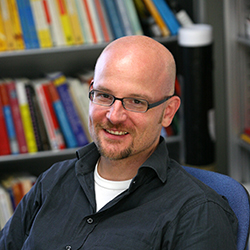Dirk Brockmann Discusses COVID-19 Spread
Brockmann, professor at the Institute for Theoretical Biology at Humboldt University of Berlin and the Robert Koch Institute, detailed his studies on the dissemination of the coronavirus
Understanding how and why COVID-19 spreads where it does is one of the great challenges of the pandemic. Knowing the mechanisms for its movement can help prevent worsening infections and limit the extent of damage when it does hit a certain area.
One of the other lingering questions is why the response and the information environment in the US has been different from much of the world, and what impact that’s having. Dirk Brockmann, professor for theoretical biology at the Humboldt University of Berlin, hypothesized that the disease unfolded stronger in individualistic countries like the US than it did in more collectivistic nations.

During his November 13 presentation “Understanding the COVID-19 Pandemic: Math, Models, Mobility, and Taking a Nation’s Temperature” that kicked off the 2020-21 Dean’s Seminar Series at Northwestern Engineering, Brockmann discussed his multi-pronged research into the dissemination of the virus.
“When people are aware that they can infect someone else, if that awareness is dominant in their behavioral changes, it is less dramatic,” said Brockmann, formerly a professor in the engineering sciences and applied mathematics department at the McCormick School of Engineering. “There’s one study that I know is looking into this, and that could be part of it. The quick response from many European countries and the quick adoption of containment measures like wearing face masks and other lockdown methods that limit your personal freedom (were different).”
Based on methods and models he developed at Northwestern Engineering, Brockmann and his colleagues used worldwide air transportation statistics to estimate the import risk and arrival time of the virus in various countries.
Some airline routes are busier than others. In that sense, somebody in New York is connected more closely to people in London than those in Pittsburgh. International hubs for airlines are effectively “close” to Wuhan, China, where the outbreak began.
“We tried to define a relation between the probability of going somewhere and the effective distance between locations,” Brockmann said, “and replace the actual geographic distance, which is part of the traditional way of looking at maps, and replacing it with effective distance.”
Brockmann’s group went deeply into the first wave, comparing the outbreak curves from different countries. Brockmann said an exponential increase would be expected, but growth in places like China or Italy was actually algebraic or sub-exponential. The US, meanwhile, was purely exponential.
An explanation, Brockmann said, stems from a combination of the feedback loop of how policy differences, the disease’s dynamics, behavior in each country, and psychological processes affect each other.
To explain the discrepancy, Brockmann closed the feedback loop between behavior and disease dynamics. The mitigating factor was how proactive countries were, whether it was by wearing masks or strict quarantining that removed susceptible people from the disease’s path.
Another project applied to Germany, where local phone companies donated the localization data of cell-phone users that showed movement patterns. By monitoring mobility, Brockmann found that movement changed during the first wave of the pandemic, with long-distance traffic becoming more limited than short-distance movement. But that type of change doesn’t slow the virus’ spread if it’s already everywhere.
He also looked at how data on resting heart rate, physical activity, and sleep collected through smartwatches of 531,624 participants led to the design of a national fever thermometer to predict the time course of confirmed cases of COVID-19 in Germany. People with fevers develop a higher resting heart rate but tend to walk less, and Brockmann’s team found that fever measurement corresponded to the epidemic. The team’s tracking, Brockmann noted, is slightly faster than the country’s case reporting system.
Brockmann also explained that the combination of urbanization, the connection between humans and animals, and global mobility create opportunities that are ripe for a pandemic.
“All of these factors are key to the increased emergence of new viruses in the human population,” Brockmann said. “The coronavirus is just the latest and most severe example of a pandemic.”